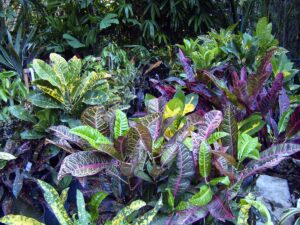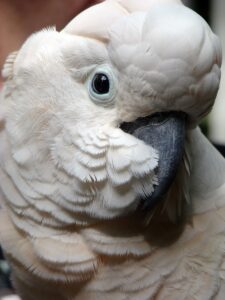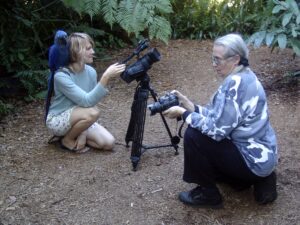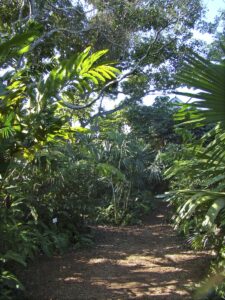The beautiful parrots were bantering back and forth; giant palms obscured light from above; large leaf exotic plants obstructed the path. I felt like a Lilliputian in a land of overlapping green giants, each one poised to grab me should I dare to slow down a bit to gawk. Yet the diversity and unfamiliarity of the plants and trees make it hard not to gape. The only question remained: How did this tropical rainforest end up in Nancy Forrester’s backyard in Key West, Florida?
 Billed as Nancy Forrester’s Secret Garden –- and indeed located as it is at the end of a hidden, narrow dirt lane, it well deserves its moniker -– the story behind its creation is as intriguing as a stroll among its many trails. It all started some 40 years ago, when painter and photographer –- and currently self-described eco-artist — Nancy Forrester’s keen eye saw some promise in the then-undesignated city dump. Once she and her family moved in, “we just cleared up the debris and started gardening. It evolved into a rainforest almost by design, as my artist friends and I planted mostly tropical exotic shade plants at random.”
Billed as Nancy Forrester’s Secret Garden –- and indeed located as it is at the end of a hidden, narrow dirt lane, it well deserves its moniker -– the story behind its creation is as intriguing as a stroll among its many trails. It all started some 40 years ago, when painter and photographer –- and currently self-described eco-artist — Nancy Forrester’s keen eye saw some promise in the then-undesignated city dump. Once she and her family moved in, “we just cleared up the debris and started gardening. It evolved into a rainforest almost by design, as my artist friends and I planted mostly tropical exotic shade plants at random.”
 Asserting that “the natural world has always been my teacher and the theme of my art,” she credits her love of nature and a simple basic style of living as inspiration to protect the land from overdevelopment.
Asserting that “the natural world has always been my teacher and the theme of my art,” she credits her love of nature and a simple basic style of living as inspiration to protect the land from overdevelopment.
As the last remaining undeveloped wooded acre in the town, it now houses 100 different species of palms, ferns and orchids and vast quantities of lush aroids (the aforementioned giant foliage), set amidst 100+-year-old fruit trees. Many are rare and endangered, and have developed into a select gene pool that can keep a species alive. And although I don’t know what an angiopteroius fern is, I was impressed when Nancy claimed she has five different varieties and that hers is the only garden in the country to have them. Not to mention that her endangered cycads date from the time of the dinosaurs. That’s good enough for me.
The plants are not the only endangered species around; so are some of the 22 parrots that call the forest home. Many of them are being lovingly nursed back to health from a variety of parrot ailments. The garden doubles as a non-profit humane society, at one time housing 100 birds, although Nancy has since limited her brood to 22: “We have to make sure we can safely evacuate them all in the event of a hurricane,” she explains.
 And these are no ordinary birds; they each boast a definitive personality of their own. Imaginative write-ups list their origin, vocabulary — some of which is quite extensive — their history, favorite treats, likes and dislikes, foibles and frailties. Well, okay – maybe not so much. But beautiful Ara, for example, sings opera, eats pizza, and loves shoes and dancing, and happily spreads her wings upon request. Mr. Peaches, a handsome screaming white cockatoo, is a rescue from New York City where he frequently rode the subway, likes broccoli, dislikes pecans and is especially fond of salsa and chips. Choo Choo, formerly Chatsworth whose favorite meal is breakfast, actually sneezes just for fun, and Rock, a high-energy Hawk-headed parrot, is the star entertainer who flirts with everyone, whistles, sings, does a fabulous wicked witch impersonation, and insists on bathing in his water bowl even on the coldest days of the year. His “Hi Baby, whatcha doin’?” is a frequent refrain.
And these are no ordinary birds; they each boast a definitive personality of their own. Imaginative write-ups list their origin, vocabulary — some of which is quite extensive — their history, favorite treats, likes and dislikes, foibles and frailties. Well, okay – maybe not so much. But beautiful Ara, for example, sings opera, eats pizza, and loves shoes and dancing, and happily spreads her wings upon request. Mr. Peaches, a handsome screaming white cockatoo, is a rescue from New York City where he frequently rode the subway, likes broccoli, dislikes pecans and is especially fond of salsa and chips. Choo Choo, formerly Chatsworth whose favorite meal is breakfast, actually sneezes just for fun, and Rock, a high-energy Hawk-headed parrot, is the star entertainer who flirts with everyone, whistles, sings, does a fabulous wicked witch impersonation, and insists on bathing in his water bowl even on the coldest days of the year. His “Hi Baby, whatcha doin’?” is a frequent refrain.
As Nancy entertains visitors with tales of her garden and animal escapades, her prized blue Brazilian parrot, Baby, often hangs upside down on her perch, swinging and doing calisthenics. Nancy’s devotion to her pets and plants is contagious, and her conviction that we are “morally obligated” to save “Earth’s life forms” heartfelt. “Here, art is experience,” she enthuses. “Come to be inspired. Draw, paint, and write poetry. Sing and dance. Help celebrate 40 years of green living and sustainable behavior.” The fact that it’s in the heart of Key West is an added bonus.
As Amanda Albert of New Orleans crowed: “It makes me so happy to come here. I return every year. It’s so rare to see such wonderful birds –- and to think, you saved them all.”
But given the expense of maintaining such a special world, and the fact that the few visitors who are actually able to find the garden have diminished recently due to the downturn in travel everywhere, pleas for donations are in evidence at almost every turn. But the sense of imposition is offset by their sense of whimsy.
Upon entry, where the admission is $10 per human, one is greeted by a sign proclaiming: “If I am not in the garden to greet you, it is because I am underfunded, short-staffed and working to stave off development.” Further down a small graded nook: “Imagine this area gone and in its place 9.1 residences each with a parking space for 2 cars.” And intermingled among the parrot lairs: warnings not to pay attention to the ‘screaming’ white parrots: “No eye contact; No smiling; Turn your back and walk away” -– but essentially, please leave something behind for their care.
There is much to see in Key West itself, a city where anything goes, where everyone feels comfortable. It’s a city of contradictions. It’s a city that’s part New Orleans, part island getaway. A town where honky tonk sits comfortably with tropical vegetation on the same barstool. Where man-made tourist attractions thrive beside the intrinsic culture, history and lifestyle of the island. These are the things that draw people to Key West.
And Nancy Forrester’s Secret Garden provides a private haven of its own, a chance to reflect upon the history that is still Key West today. Let the serenity transport you to another era when life was a lot simpler, streets a lot safer, and the pace of living a lot slower. And you’ll also want to return, as so many others have, year after year. I just hope it continues to survive long enough for that to be possible. For more information, call 305/294-0015 or visit www.nancyforrester.com.

